BTR Ranger 27.5, Custom
Size Tested: Custom (Effectively an XL 27.5, but with a 62° head tube angle and the seat tube and head tube shortened to 440 mm and 130 mm, respectively.)
Stock Geometry: (Here)
Build Overview:
- Fork: Fox 36 Float RC2, 120 mm travel
- Drivetrain: Shimano XTR M980 1×10 speed
- Brakes: Formula R0 Racing
- Wheels: DT EX511 rims, Hadley hubs, DT Super Comp spokes
Wheel Size: 27.5” (available in 26”, 27.5”, and 29”)
Measured Weight: 29.2 lbs as pictured, including pedals and a single Cush Core insert in the rear.
MSRP (Frame Only): £1000 (~$1,200 at the time of writing) for stock geometry. Customization available for an upcharge.
Reviewer: 6’, 165 lbs
Test Locations: Washington & Oregon
Test Duration: ~2 years
[Note: Our review was conducted on a 2017 Ranger 27.5, but the bike has not been changed for 2018 or 2019.]
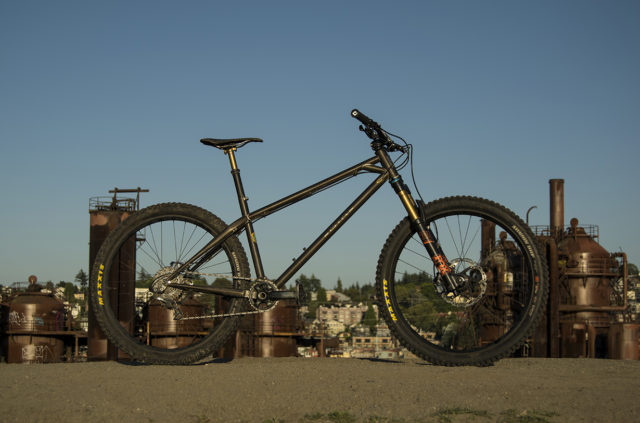
Intro
BTR is a small, two-man outfit based in England, best known for making downhill-oriented hardtails. Paul “Burf” Burford and Tom “Tam” Hamilton met at university and bonded over a shared ethos favoring simple, dependable, and beautifully constructed bikes. Their first model, the Belter, was born out of a desire to make a DH hardtail that would handle like a proper downhill bike, but make some of their tamer local tracks a bit more exciting. Now their range has grown to include a full spectrum of hardtails from a single-speed XC bike through an updated version of the Belter, as well as a short-travel full-suspension bike, the Pinner.
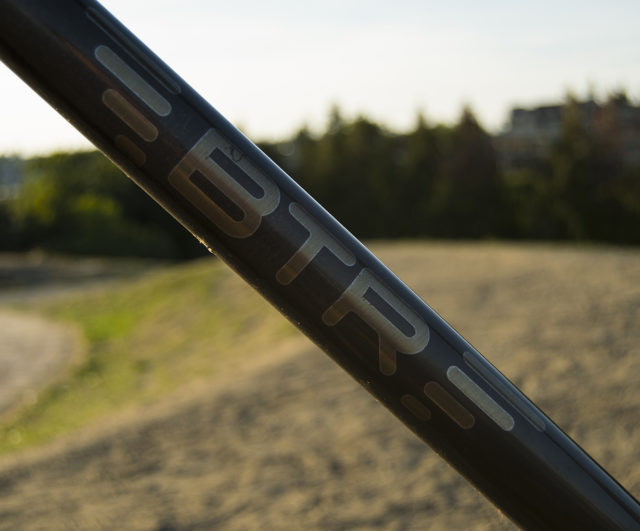
Here we’re reviewing the latest edition of the Ranger, BTR’s Enduro hardtail (yep, that’s a thing), which has been one of my personal bikes for the last couple of years.
The Frame
BTR builds all their frames using a mix of high-end steel tubing (the Ranger features a mix of Reynolds 853 and 631 tubes in the front triangle, and Dedacciai stays) that’s TIG-welded with stainless steel filler rod. BTR has a detailed blog post on their welding process that you can check out here, but in short, they claim it produces a modest increase in strength and ductility of the joint, and the stainless rod also just looks really cool through the “BTR raw” finish on this frame.
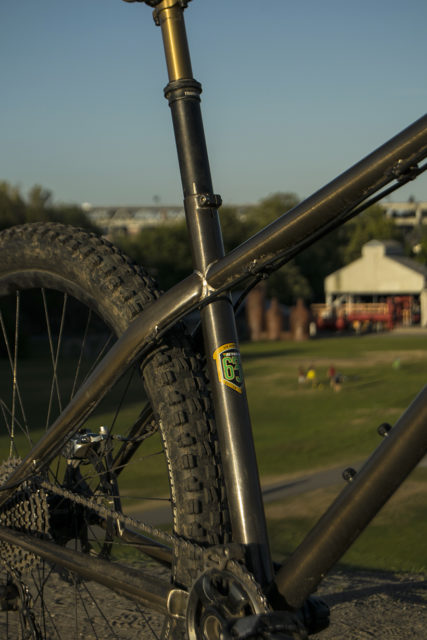
BTR’s frames are all made to order, and many of the details are highly customizable. BTR offers the frame in any wheel size you’d like (26”, 27.5” and 29” are all on the menu), with either a 142 mm or 148 mm Boost rear end, your choice of internal or external cable routing on a cable-by-cable basis, an optional ISCG ‘05 chain guide mount, and so on.
I opted to include the chain guide mount and integrated seat clamp, and went with internal routing only on the seat post cable. BTR uses a brazed-in, full-length stainless steel tube to contain the internally routed housing and guide it through the frame, making for the simplest and easiest internal routing I’ve dealt with to date. (They have a really interesting article about how they settled on this method of internal cable routing.)
I also opted for a 142 mm rear end, which in hindsight, I regret; I’m not at all convinced that Boost is particularly better, but it does seem to have won out in the marketplace, and opting for that would have made swapping wheels between bikes a bit easier.
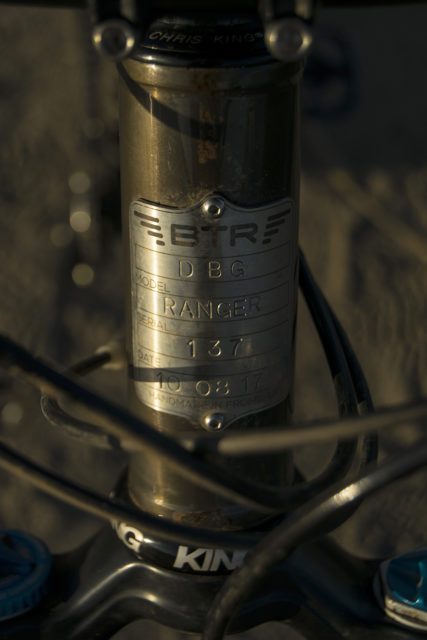
[One note on cable routing: BTR default to setting up the bike to run the front brake on the right side, and routing the cables so that they pass the head tube on the same side as the control they’re attached to. If you want something different, as I did, let them know and they’ll be happy to oblige.]
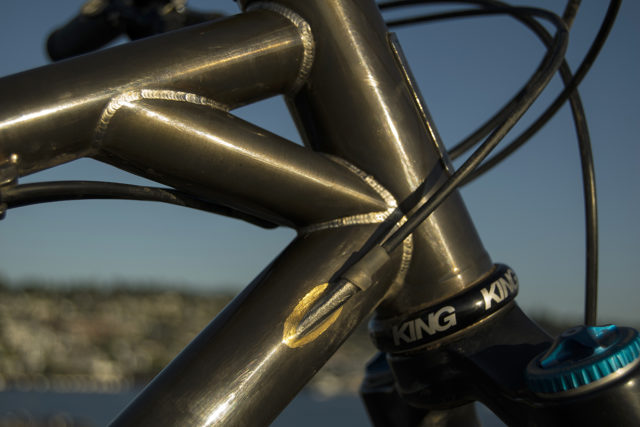
Befitting a tailor-made frame, BTR frames are available in just about any color imaginable. I opted for what was, at the time, their standard finish, which is basically a slightly brown-tinted clear coat. BTR has had to move away from this option, since it does tend to show little bits of superficial rust through that develop under the clear coat. It’s still on offer if you ask, but they’re not able to warranty the finish. Mine is showing a few small spots under the powdercoat, but I’m not too bothered by it — if anything, I think it gives the frame a kind of Steampunk-looking patina.
One of the standout features of the Ranger is that, despite being marketed as an Enduro bike and having quite slack, aggressive geometry, it’s designed around a fork with a mere 120 mm of travel, whereas most of its competitors are in the 140-180mm-travel range. Having owned and ridden a number of other aggressive hardtails (most notably the Chromag Stylus), I actually think this is a great call on BTR’s part.
No amount of front suspension is going to make a hardtail feel super plush and forgiving, and having a huge amount of front-wheel travel paired with none in the rear means that the head tube angle dramatically steepens, and then the front end gets much lower in the exact moments when you’re hitting something really hard and therefore most need the chassis to stay composed and stable. I’ve likened the feeling to riding a stapler down a hill. The Ranger sacrifices a bit of squish with the goal of actually improving chassis stability, to great effect. The combination of a short-travel hardtail with extremely long, slack geometry may on the surface seem to be an odd one, but there’s sound reasoning behind it, and in my experience, the combination works extremely well.
The Build
My Ranger is built up with a Fox 36 Float RC2 fork that’s lowered to 120 mm of travel, a 1×10 Shimano XTR drivetrain, and DT EX511 / Hadley wheels. For tires, I mostly run some combination of a Maxxis Minion DHF, DHR 2, and / or Shorty in Exo and Double Down casings, usually with Cush Core in the rear.
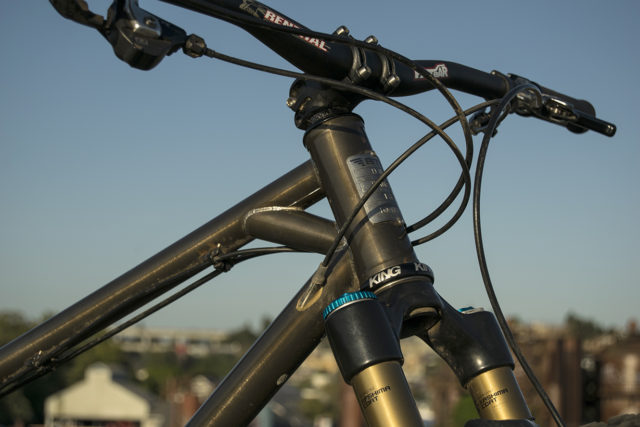
Formula RO Racing brakes handle stopping duties, and a Renthal aluminum bar, Syntace Megaforce stem, 150 mm Fox Transfer dropper post, and Selle Italia SLR saddle round out the rest of the build. I ride a mix of flat pedals (Specialized Boomslang) and clips (XTR trails and Saints) depending on mood / weather / trail conditions / moon phase / etc.
The Range frame alone starts at £1000 (~$1,200 at the time of writing) for the stock geometry, with customizations bumping up the price slightly. BTR also currently sells “frame kits” (frame + headset + fork) starting at £1810, and then they currently have two full builds (named after the brand’s founders) that go for £3500 and £3100.
Fit & Geometry
As I noted above, the geometry on my bike is tweaked a bit from BTR’s stock options, but the changes aren’t huge for the most part. I started with a stock 27.5 XL frame, which has a 480 mm reach, 420 mm chainstays, and a 63.5° head tube angle. The biggest change I made was to slacken the head tube to 62°. That might sound really slack for a hardtail with a 120 mm fork, but my reasoning was twofold.
First, it’s a hardtail; it only ever gets steeper as it cycles through the travel, unlike a full-suspension bike that has rear-wheel movement to balance things out. Second, a lot of my local trails are quite steep, and I figured that pushing the front wheel out a bit more would help keep the bike composed on those trails. I also shortened the head tube to 130 mm from 150 — I tend to run my bars a bit lower than average, so this gave me a bit more room to fine tune, and shortened the seat tube to 440 mm from 455 mm. I would have been fine with the stock XL seat tube length, but I was already paying for customizations, and again, going shorter bought me a bit more room to experiment with super long dropper seat posts and the like.
One noteworthy thing about the Ranger geometry is that BTR increases chainstay length with frame size on the 26” and 27.5” frames. (I suspect the chainstay length on the 29” version is dictated by tire clearance, and they didn’t want to go even longer on the bigger sizes.)
I think this is really smart, and it’s something I’d like to see a lot more companies doing. Scaling up the chainstays proportionally to the increased reach helps maintain a consistent weight balance between the front and rear wheels across the size range, and that has a big impact on how a bike handles. In my mind, keeping the same chainstay length across a full range of sizes is a bit like if a ski manufacturer changed ski lengths by adding all the extra length in front of the toe piece. There’s a reason nobody does that, and I think it’s really cool to see bike companies finally catching on.
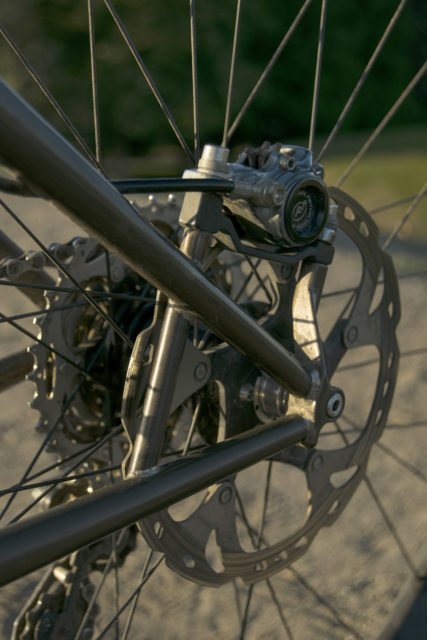
The Ranger occupies a really interesting niche within the mountain bike world — a bike with very progressive, long / low / slack geometry, but with very little suspension. Generally speaking, lots of suspension and more aggressive geometry tend to be paired together, and bikes on the shorter-travel end of the spectrum tend to get steeper and shorter.
In a lot of cases, this does make sense, but it’s cool to have other options too. Geometry drives handling, and a bike that blends the nimble, direct precision of a short-travel bike with the handling of a much more downhill-oriented frame can be incredibly fun. There probably aren’t many real-world situations where the Ranger is the absolute fastest bike out there, but to judge it on those terms is missing the point. The Ranger is extremely capable for a hardtail, but also fun and playful in a way that the latest crop of ~160mm-travel Enduro sleds can’t hope to match.
And if all this talk of geometry numbers sounds confusing, we encourage you to check out our Geometry & Fit 101 articles.
The Ride
The handling of the Ranger isn’t quick in the way that, say, an XC race bike is, but it feels exceptionally precise.
With little suspension to mute inputs and trail feedback, the Ranger offers a direct connection to the ground in a way that a full-suspension bike doesn’t. This, of course, also means that the Ranger isn’t terribly forgiving of sloppy line choice or just pointing the bike into a rock garden and hoping for the best — we are talking about a hardtail, after all.
Riding the Ranger at high speeds requires a more active style than a long-travel full-suspension bike would, with deliberate line choices and more care taken to move the bike around to pick it up over and pump off of trail features instead of sitting back and letting the bike do the work. Getting this right takes a bit of extra effort, but when it all comes together, it’s incredibly rewarding and just flat-out fun. The long wheelbase, slack head angle, and roomy cockpit of the Ranger also mean that it’s capable of going way, way faster through rough, technical trails than a hardtail feels like it should have any right to, provided that the rider is up to moving the bike around to manage the impacts.
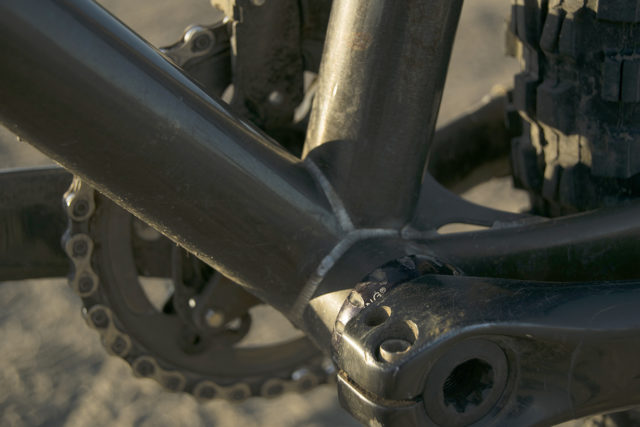
Comparing the Ranger to most modern full-suspension bikes, I’m a little slower on most technical descents, but the gap isn’t huge at all. I haven’t done any quantitative timing, but rather base that off of chasing friends I ride with often and have a good baseline against. Riding the Ranger is more fatiguing than trying to charge on a full-suspension bike, but if you bring your A-game, the Ranger can really move.
Unsurprisingly, the Ranger excels at putting power down — with no rear suspension to soak up pedal inputs, standing up and punching it on a climb or out of a corner is rewarded with instantaneous acceleration. Keeping traction over really rough sections of a climb can take a little extra effort, but the ability to throw a quick pedal stroke and have the bike really take off goes a long way towards compensating for that, and it’s easy to move the bike around and place the tires to maximize what traction can be had. Again, compared to a full-suspension bike, the Ranger tends to require a little more precision, but also rewards that extra effort with impressive results.
In terms of where the Ranger excels, I think it’s less about terrain, and more about getting a different experience on your typical trails. For reference, I tend to use the Ranger on the same trails on which I use my Nicolai G16 (a super-long, super-slack bike with 155 mm+ of rear travel and a 180 mm dual-crown fork). Obviously, these are two very different bikes, but my decision of which bike to grab usually just comes down to which one I feel like riding — i.e., it’s less about the Ranger feeling out of place on any particular trail, and more about whether or not I want the more plush feel of a full-suspension bike, or the more precise feeling of the Ranger.
The Ranger feels less like a tool for a specific job, and more just like a really excellent bike with a bit of a different character than a typical Enduro full-suspension rig. I use it for everything from goofing around on my neighborhood dirt jumps, to all-day epics with 6000+ feet of climbing and descending. For me, the only thing that isn’t much fun on the Ranger is super firm, bike-park-style trails with lots of braking bumps where some rear suspension makes things much more comfortable.
The Bottom Line
The Ranger probably isn’t a bike that makes sense for everybody, but each attempt I make to winnow down the sorts of people it would work really well for feels like I’m pigeonholing it far too narrowly.
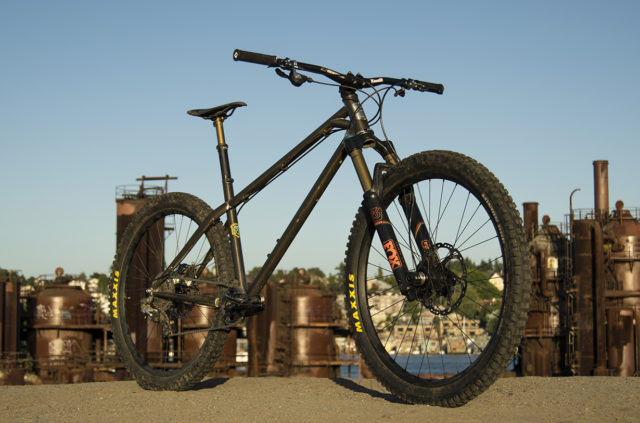
Do you want a bike to add a bit of challenge and freshen up your local trails that you’ve ridden a million times on a burly full-suspension Enduro bike? Ranger. Does a big full-suspension Enduro bike feel like overkill for where you ride, but you don’t like the twitchy handling of shorter-travel Trail / XC bikes with short and steep geometry? Ranger. Maybe you want to try racing the hardtail class in some Enduro races? I can’t think of a better option.
I also firmly believe that riding a Ranger, and especially trying to go fast on one, will make you a better rider. It’s not as forgiving as a full-suspension bike at high speeds, but if you nail your lines and avoid mistakes, the Ranger is astonishingly fast, and practicing that precision will absolutely carry over once you put some more suspension underneath you.
Most importantly though, if you read this review and found yourself thinking “hey, this bike sounds like fun,” I can assure you that it really, really is. The Ranger blends a big helping of technical capability and speed with far more playfulness and, for lack of a better word, fun-factor than you’ll find in a more traditional Enduro race bike. Yes, it’s more demanding and more fatiguing in rough terrain, and no, I wouldn’t really want to ride a bike park on one for more than a few laps. But if my house was burning down and I only had time to save one bike, nine times out of ten I’d grab the Ranger.

I really hope your house isn’t gonna have to burn down 10 times to verify that claim.. :D Awesome review btw!
Owning a (slightly different) long slack hardtail and a Nicolai myself, it’s hard to believe you’d let the G16 burn. I know what you must have paid for that thing! At any rate, I couldn’t agree more with this review for this type of bike. I think you’ve inspired me to shorten the travel on my Pedalhead’s fork a bit.
Ah, well, I’ve got renter’s insurance and the G16 feels a bit more fungible than the custom BTR.
Glad you enjoyed the review! What fork are you running on your Pedalhead?
MRP Ribbon (air) @ 140mm currently.
Cool. If you’re feeling inclined to tinker, I think going a little shorter could be a worthwhile experiment!
How is tire clearance? 2.4 DHR II okay? Looks fun, cool to see the other end of the Doctahawk spectrum.
A 2.4 DHR2 or a 2.5 DHF fit comfortably. You could probably stuff something a little bigger in there, but it wouldn’t leave much mud clearance.
That’s a great review of an interesting bike. I too am in the process of choosing either a Ranger or a Belter. Your custom geo bridges the gap between the two bikes. I may do the same thing. I have two questions,
How does it handle tighter twisty single track? does the slack HA slow it down?
Why did you choose 275 when 29ers are the in thing? …for now.
cheers, beautiful bike and great review. Thank you
cheers
kev
I wouldn’t get too fixated on the headtube angle. Between the short fork and moderate chainstays, the wheelbase isn’t terribly long (don’t remember the exact number off the top of my head) and it feels just fine in tighter stuff.
As far as wheelsize goes, I personally tend to prefer the handling of 650b wheels. I also tend to run my bars a bit on the low side, and the extra height of the bigger wheel and longer fork would have made it harder for me to get the bike set up as I’d like it.
I know this review is a couple of years old now but hoping to get some kind of response
I have a Cotic bfe (last of the 27.5) and it’s great but after getting an enduro bike it feels very much too beefy a bike for what I use it for, which is more the long all day epic xc rides and tearing down the local steeps than bike parks and black off piste runs I used to do more of on it, I was originally going to try and swap the frame out for a Stanton slackline but a ranger frame has come up for sale and I’m contemplating that, my question is really, how does it handle xc-trail long days (50-100 miles and 4000-6000ft) or with it being so slack would it suck on the flat bits?